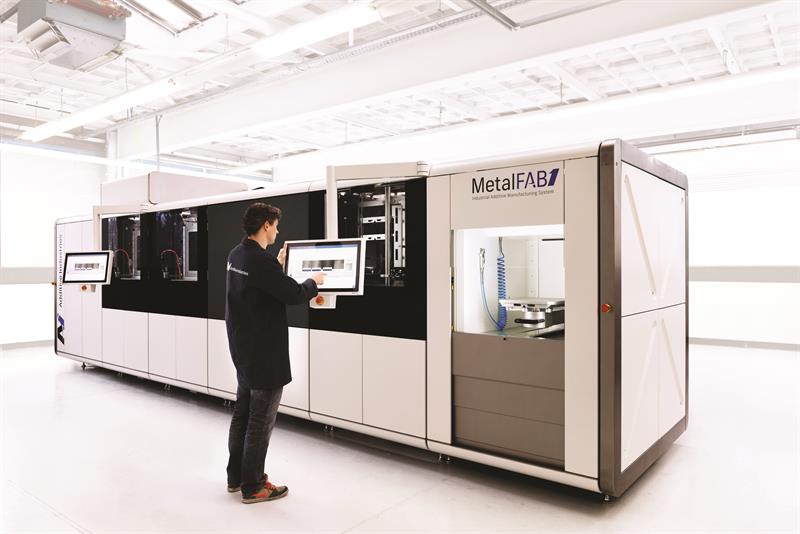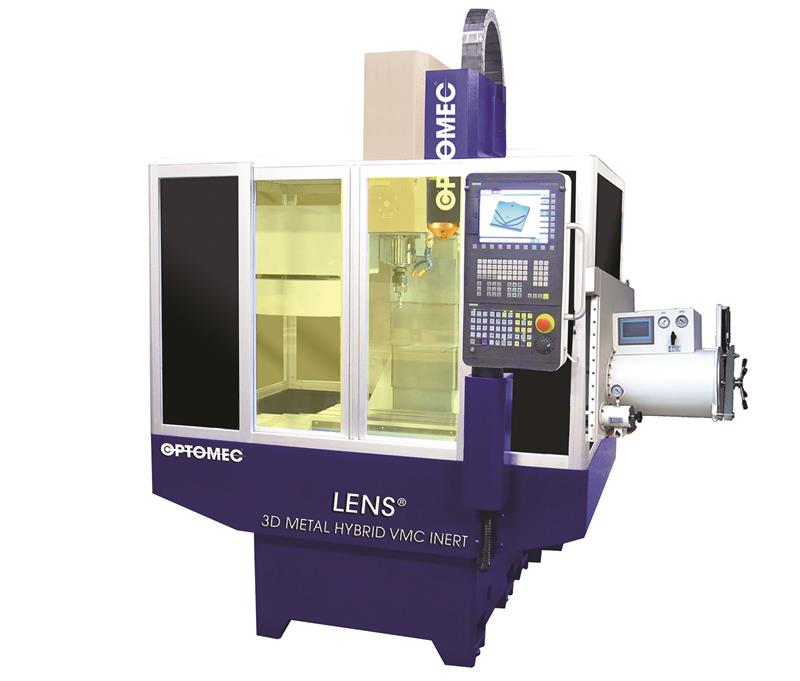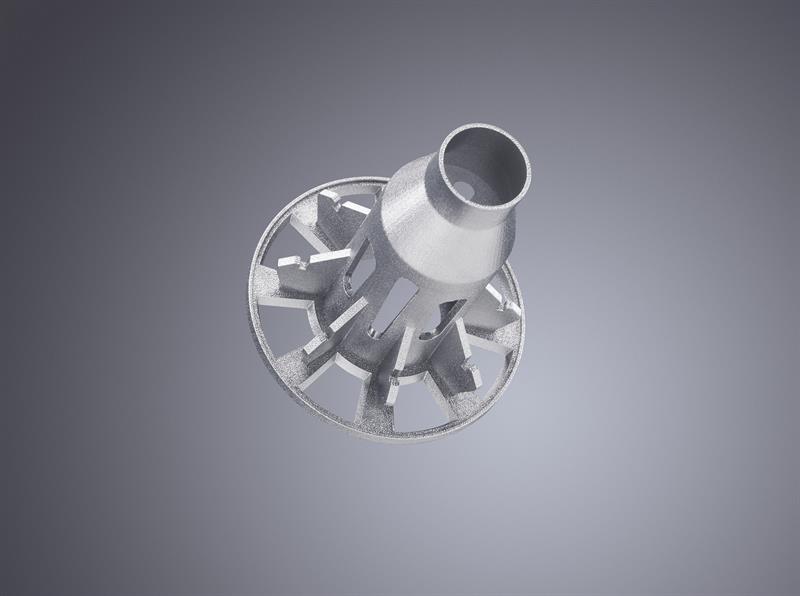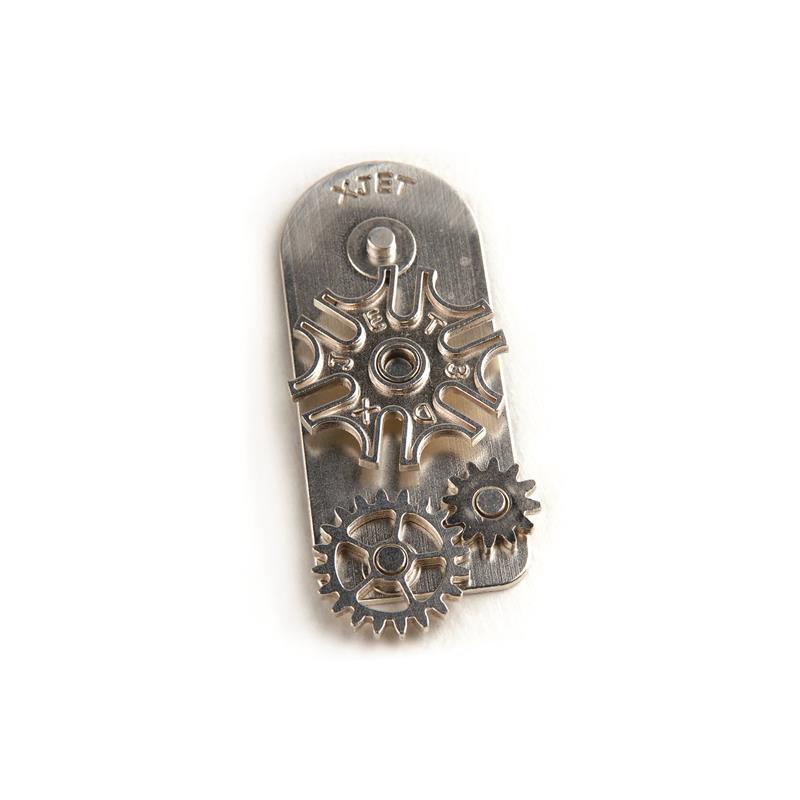Exhibitor bookings are up almost a third (29%) to 261, and exhibition space is up more than a third (41%) to 15,500 m² this second year; the exhibition is in Frankfurt Messe Hall 3. Of the event, exhibitor Concept Laser says: “It is already becoming increasingly apparent that Formnext powered by TCT is the new leading trade fair for 3D printing in Europe.” Exhibitors are alphabetised in the listing below.

Additive Industries’ MetalFAB1 machine
Additive Industries (H60; +31 40 218 0660) of the Netherlands is likely to show its new MetalFAB1 3D metal printing system. Intended for industrial use, the machine incorporates multiple 420 by 420 by 400 mm build chambers (measurements in X, Y and Z) with individual integrated powder handling, allowing up to four materials simultaneously. In what is claimed to be a unique feature, there is a furnace for integrated heat treatment for part stress relief; the machine also features automation of build plate and product handling. The company, which signed a technology licensing agreement for EOS’s direct metal laser sintering process in late 2015, delivered its first beta-testing unit of the MetalFAB1 and its proprietary Additive World software to Airbus APWorks in April; the first production machines are due to be delivered later this year.
Aicon/Hexagon (D28; 01952 681300) is showing PrimeScan, an entry-level system for 3D digitisation of industrial components using optical scanning. As its base is only as big as an A4 sheet and the system weighs only 4 kg, the scanner is suitable for measurements in tight places. Another product is the StereoScan neo that not only projects a new colour fringe pattern, but also the measuring results (including deviations), under the rubric of ‘See What You Measure’.
Altair (Stand E50; 01926 468 600) – simulation software HyperWorks 14.0, concept design tool solidThinking Evolve and manufacturing development software Inspire 2016.
Arburg (F70; 01926 457000), the plastic injection mould machine manufacturer, demonstrates its Arburg Plastic Freeforming technology that uses conventional plastic granulated feedstock to create one-off or small batches of parts. The Freeformer is equipped with a 3-axis part carrier and two stationary extruder units. Therefore, it can process two components at the same time, so parts can be produced in different colours, with special tactile qualities.
Concept Laser (F48; ES Technology, 01865 821818) releases a new, modular machine architecture that emphasises parallel, over sequential, processing steps. It is intended to deliver series production; explanation of how it will fit into a vision of an AM Factory of Tomorrow is also promised. In future, there will be stand-alone process stations for the build process with a build envelope of 400 by 400 by greater than
400 mm (in X, Y and Z) that will have one to four laser systems featuring multiple lasers of 400 to 1,000 W laser sources. Other features include a new 2-axis coating process, automated toolchanger and automated material flow.
Dassault Systèmes (Stand D99; New Technology CADCAM, 01844 295235) – likely to show its new Solidworks 2017 CADCAM software.
EOS (G70; 01926 623107) will show the M 400-4 machine, its biggest and fastest for its direct metal laser sintering process; the model offers a 400 by 400 by 400 mm build volume and is equipped with four 400 W lasers operating in 250 by 250 mm squares with 50 mm overlap. The system builds on the well-process used in predecessor M 290 machine. Initial materials available for use on the machine are EOS NickelAlloy HX and EOS MaragingSteel MS1. The machine was first launched at the IMTS machine tool show in Chicago last month (p19).
Farleygreene (01256 474547) presents its new additive manufacturing powder sieve, the SG 400-US. The automated, dust-tight machine employs an ultrasonic screening system for classifying and recycling metal and fine powders before or after builds.
GF Machining Solutions (H80; 02476 538666) will present its additive solution for printing metal inserts for mould and die. The AgieCharmilles AM 290 S Tooling is a system configured for plastic injection and die casting companies. With a System 3R MacroMagnum chuck integrated into its build platform, the AM S 290 Tooling leverages System3R’s Reference Point Calibration software to permit location of parts relative to the build platform, which is said to significantly improve the ability for upstream and downstream integration of the AM process in production.
HC Starck (K75; 01249 822 122) is a new supplier of metal powders for additive manufacturing; its product is the Ampersint brand of gas-atomised metal alloy powders.
HP (K50; https://is.gd/xovabu), takes the biggest stand; it will probably offer the first opportunity for Europeans to see its two new plastic 3D printers: HP Jet Fusion 3D 3200 printer (for prototyping) and 4200 printer (prototyping and short-run manufacturing). HP claims that the technology “delivers superior quality physical parts up to 10 times faster and at half the cost of current 3D print systems”. Design software partners include Autodesk, Materialise and Siemens. The 4200 model is due out this year.
InssTek (K69; www.insstek.com) is launching what it claims to be the world’s first desktop-scale metal 3D printer: the MX-Mini. Its exterior measures 800 by 800 by 800 mm, and offers a build volume of 200 by 200 by 200 mm. The South Korean company points out that, although small, the machine employs a directed energy deposition system using the same algorithm as other models; in particular, it can print multiple materials.
Materialise (F28; 0114 254 1249) will present updates of the Materialise Magics 3D print suite that guides users from data preparation to production management and machine control. The software imports all data types and formats, repairs and prepares files for all technologies, allows data editing and enhancement, prepares build platforms, and takes inputs from reports and measurements for quality control.
Matsuura (E48, 01530 511400) will show its new Lumex Avance 60 hybrid metal AM machine, claimed to be the largest powder bed metal 3D printer in the world (600 by 600 by 500 mm in X, Y and Z). Launched in Japan only in July, one unit of the model has already been sold in Europe. Maximum part weight is 1,300 kg; and, compared to its older sibling the Avance 25 (that is installed at the MTC in Coventry), it also offers increased AM deposition rates (35 cm³/hr) thanks to a 1 kW fibre laser. Not only does it grow parts, it cuts them too; feedrates are up to 60 m/min in X and Y; 30 m/min in Z; spindle speeds are up to 45,000 rpm. The machine additionally features an automatic powder supply, collection and reuse system as standard. Mould and die makers are a particular target for both models; their capabilities suit the production of dies with deep pockets.
MSC Software (K44; www.simufact.com) will launch its process simulation software Simufact Additive to predict the final distortion and residual stresses of 3D-printed metal parts. The modelling is based on CAD data.
Open Technologies (Stand B89, +39 030 3543106) – the Cronos 3D optical video scanner; three times as fast and twice as accurate as its predecessor.

The Lens 3D Metal Hybrid VMC Inert System from Optomec, a hybrid additive/subtractive machine with a controlled atmosphere
Optomec (Stand D05; Semitronics, 01242 253343) is likely to present the European debut of its hybrid AM/subtractive machine that was launched at the IMTS show in Chicago in September. The Lens 3D Metal Hybrid VMC System, one of three standard configurations in the new range, combines additive and subtractive operations on the same machine at low cost. In a metalworking industry first, a second model, the Lens 3D Metal Hybrid VMC Inert System, can maintain oxygen and moisture levels at less than 40 ppm by replacing the upper enclosure of a CNC machine from US brand Fryer Machine Systems with an Optomec proprietary hermetically-sealed chamber and gas purification system. The third model, the Lens 3D Metal Additive System, provides open atmosphere, AM-only processing for less than $250,000. First customer shipments are said to commence in early 2017.
OR Lasertechnologie (Stand E70; www.or-laser.com) may show off the new coaxial powder nozzle it has developed for automatic laser-based cladding. Available as an add-on for existing AM 2.0-capable laser cladding systems, it feeds metal powder into the laser beam that is then transmitted to the part surface, automatically, instead of requiring a welder to feed filler wire almost entirely by hand, as in the conventional laser cladding process. It can be used on three-dimensional surfaces.
RangeVision (Stand K21; 3D Enterprise, 07865 218765) – the latest version of 3D scanning software RangeVision ScanCenter 2016.2.
Renishaw (Stand F68; 01453 524524) will showcase its latest developments and underline the role that metal additive manufacturing plays in manufacturing. Highlights on the stand will include two parts made on Renishaw AM machines: a titanium wishbone for the TransFIORmers Moto 2 motorcycle, and titanium lugs for the Robot Bike Co R160 bespoke mountain bike frame. Recently, Renishaw inaugurated its first of what is intended to be a global network of metal additive manufacturing Solutions Centres, in India; there is now also one near Cardiff. On the stand too will be the RenAM 500M AM machine, which is intended for series production.
Sigma Labs (Stand J45; www.sigmalabsinc.com) – launch of version 2.0 of its PrintRite3D Inspect in-process quality assurance software for metal AM processes.
Stratasys (Stand H40; SYS Systems, 01283 585955) – presentation of its J750 3D printer that offers multi-material capability and 360,000 colour combinations to create prototypes that are said to look, feel and operate like finished products, without the need for painting or assembly.Also, there’s a demonstration of how its additive manufacturing solutions are driving efficiencies in factory floor applications, such as composite tooling, injection molding and robust final part production. Also, a ‘Future Zone’ presents the company’s new Infinite-Build and Robotic Composite 3D Demonstrators (see also Machinery September 2016, p14).

A maraging steel impeller made in a TruPrint 1000 machine, for which new industrial application scenarios are to be presented at the show
Trumpf (Stand H20; 01582 725335) will highlight the new TruPrint 3000 that can make parts up to 300 mm in diameter and up to 400 mm high. It works on the basis of an industrial exchangeable cylinder, which allows for parallel set-up and post-processing and guarantees a high level of machine availability. Peter Leibinger, head of the Trumpf laser and systems division, says: “With the TruPrint 3000, we are shifting the focus onto the industrialisation of additive manufacturing, based on the whole process chain.”

Assembly employing metal parts made via XJet’s NanoParticle Jetting liquid-based 3D printing technology, which requires parts be post-process sintered
XJet (J30; http://www.xjet3d.com) is likely to show off its NanoParticle Jetting metal 3D printing technology first launched earlier this year. In the process, XJet’s print heads deposit an ultra-fine layer of liquid droplets containing metal nanoparticles onto the system build tray, where high process temperatures evaporate the liquid and bind the metal (the part will need sintering afterwards). Delivered as sealed cartridges, the liquid dispersions are easily loaded into the XJet system.
Other relevant exhibitors include: Fives Michelin Additive Solutions-Addup, Alphacam, Arcam, Autodesk, Ametek, GKN Sinter Metals Engineering, GOM, Keyence, LPW Technology, Hermle, Nikon Metrology, DMG Mori/Sauer Lasertec, Sciaky, Siemens Digital Factory Division, Sigma Labs, SLM Solutions, Voxeljet, Werth and Carl Zeiss.
This article is a combined from the October and November 2016 issues of Machinery magazine.










